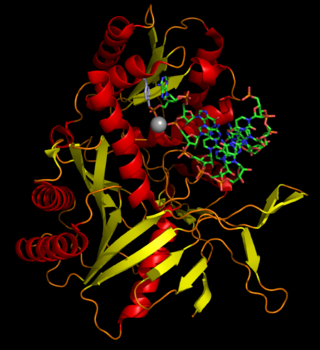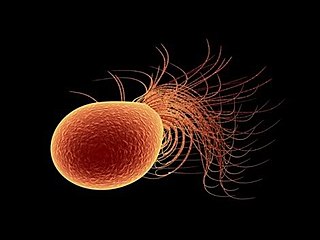
An extremophile is an organism that is able to live in extreme environments, i.e., environments with conditions approaching or stretching the limits of what known life can adapt to, such as extreme temperature, radiation, salinity, or pH level.

A thermophile is an organism—a type of extremophile—that thrives at relatively high temperatures, between 41 and 122 °C. Many thermophiles are archaea, though some of them are bacteria and fungi. Thermophilic eubacteria are suggested to have been among the earliest bacteria.
A hyperthermophile is an organism that thrives in extremely hot environments—from 60 °C (140 °F) upwards. An optimal temperature for the existence of hyperthermophiles is often above 80 °C (176 °F). Hyperthermophiles are often within the domain Archaea, although some bacteria are also able to tolerate extreme temperatures. Some of these bacteria are able to live at temperatures greater than 100 °C, deep in the ocean where high pressures increase the boiling point of water. Many hyperthermophiles are also able to withstand other environmental extremes, such as high acidity or high radiation levels. Hyperthermophiles are a subset of extremophiles. Their existence may support the possibility of extraterrestrial life, showing that life can thrive in environmental extremes.

Archaeoglobaceae are a family of the Archaeoglobales. All known genera within the Archaeoglobaceae are hyperthermophilic and can be found near undersea hydrothermal vents. Archaeoglobaceae are the only family in the order Archaeoglobales, which is the only order in the class Archaeoglobi.

Pyrococcus furiosus is a heterotrophic, strictly anaerobic, extremophilic, model species of archaea. It is classified as a hyperthermophile because it thrives best under extremely high temperatures, and is notable for having an optimum growth temperature of 100 °C. P. furiosus belongs to the Pyrococcus genus, most commonly found in extreme environmental conditions of hydrothermal vents. It is one of the few prokaryotic organisms that has enzymes containing tungsten, an element rarely found in biological molecules.
Caldococcus is a genus of Archaea in the order Desulfurococcales.
Thermococcus litoralis is a species of Archaea that is found around deep-sea hydrothermal vents as well as shallow submarine thermal springs and oil wells. It is an anaerobic organotroph hyperthermophile that is between 0.5–3.0 μm (20–118 μin) in diameter. Like the other species in the order thermococcales, T. litoralis is an irregular hyperthermophile coccus that grows between 55–100 °C (131–212 °F). Unlike many other thermococci, T. litoralis is non-motile. Its cell wall consists only of a single S-layer that does not form hexagonal lattices. Additionally, while many thermococcales obligately use sulfur as an electron acceptor in metabolism, T. litoralis only needs sulfur to help stimulate growth, and can live without it. T. litoralis has recently been popularized by the scientific community for its ability to produce an alternative DNA polymerase to the commonly used Taq polymerase. The T. litoralis polymerase, dubbed the vent polymerase, has been shown to have a lower error rate than Taq but due to its proofreading 3’–5’ exonuclease abilities.
Thermococcus celer is a Gram-negative, spherical-shaped archaeon of the genus Thermococcus. The discovery of T. celer played an important role in rerooting the tree of life when T. celer was found to be more closely related to methanogenic Archaea than to other phenotypically similar thermophilic species. T. celer was the first archaeon discovered to house a circularized genome. Several type strains of T. celer have been identified: Vu13, ATCC 35543, and DSM 2476.

Thermococcus gammatolerans is an archaea extremophile and the most radiation-resistant organism known to exist.
Methanocaldococcus jannaschii is a thermophilic methanogenic archaean in the class Methanococci. It was the first archaeon, and third organism, to have its complete genome sequenced. The sequencing identified many genes unique to the archaea. Many of the synthesis pathways for methanogenic cofactors were worked out biochemically in this organism, as were several other archaeal-specific metabolic pathways.
Thermococcus kodakarensis is a species of thermophilic archaea. The type strain T. kodakarensis KOD1 is one of the best-studied members of the genus.
Pyrococcus abyssi is a hyperthermophilic archaeon isolated from a deep-sea hydrothermal vent in the North Fiji Basin at 2,000 metres (6,600 ft). It is anaerobic, sulfur-metabolizing, gram-negative, coccus-shaped and highly motile. Its optimum growth temperature is 96 °C (205 °F). Its type strain is GE5. Pyrococcus abyssi has been used as a model organism in studies of DNA polymerase. This species can also grow at high cell densities in bioreactors.
Thermoplasma volcanium is a moderate thermoacidophilic archaea isolated from acidic hydrothermal vents and solfatara fields. It contains no cell wall and is motile. It is a facultative anaerobic chemoorganoheterotroph. No previous phylogenetic classifications have been made for this organism. Thermoplasma volcanium reproduces asexually via binary fission and is nonpathogenic.
Thermococcus profundus is a hyperthermophilic archaeon isolated from a deep-sea hydrothermal vent. It is coccoid-shaped with 1–2 μm in diameter, designated as strain DT5432.
Thermococcus chitonophagus is a chitin-degrading, hyperthermophilic archaeon isolated from a deep-sea hydrothermal vent. It is anaerobic, round to slightly irregular coccus-shaped, 1.2–2.5 μm in diameter, and motile by means of a tuft of flagella.
Persephonella marina is a Gram-negative, rod shaped bacteria that is a member of the Aquificota phylum. Stemming from Greek, the name Persephonella is based upon the mythological goddess Persephone. Marina stems from a Latin origin, meaning "belonging to the sea". It is a thermophile with an obligate chemolithoautotrophic metabolism. Growth of P. marina can occur in pairs or individually, but is rarely seen aggregating in large groups. The organism resides on sulfidic chimneys in the deep ocean and has never been documented as a pathogen.
Thermococcus barophilus is a piezophilic and hyperthermophilic archaeon isolated from a deep-sea hydrothermal vent. It is anaerobic and sulfur-metabolising, with type strain MPT.
Thermococcus peptonophilus is a fast-growing hyperthermophilic archaeon. It is coccus-shaped, obligately anaerobic and about 0.7–2 μm in diameter. It is a strict anaerobe and grows exclusively on complex substrates, such as peptone, casein, tryptone, and yeast extract. It cannot use carbon dioxide as a source of carbon. Although it can grow somewhat in the absence of elemental sulfur, it prefers sulfur.
Saccharolobus solfataricus is a species of thermophilic archaeon. It was transferred from the genus Sulfolobus to the new genus Saccharolobus with the description of Saccharolobus caldissimus in 2018.
Methanocaldococcussp. FS406-22 is an archaea in the genus Methanocaldococcus. It is an anaerobic, piezophilic, diazotrophic, hyperthermophilic marine archaeon. This strain is notable for fixing nitrogen at the highest known temperature of nitrogen fixers recorded to date. The 16S rRNA gene of Methanocaldococcus sp. FS406-22, is almost 100% similar to that of Methanocaldococcus jannaschii, a non-nitrogen fixer.



